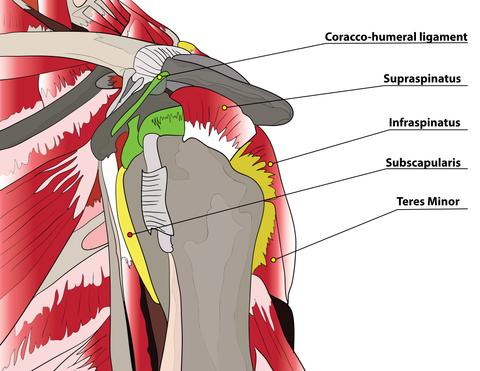Taping for Common Shoulder Injuries

There are numerous disorders that cause shoulder pain, but about 2 out of 3 cases are related to rotator cuff tendinopathy
A large portion of the population will suffer from shoulder pain at some time, with studies suggesting a lifetime prevalence ranging from c.7.0% to 70%.
Rotator Cuff tendinopathy is generally used as an umbrella term that includes many common disorders such as shoulder impingement syndrome, rotator cuff tendinitis/tendinosis and subacromial bursitis.
The causes of rotator cuff tendinopathy are multifactorial and intrinsic as well as extrinsic factors are involved.
Intrinsic factors typically relate to degeneration of the rotator cuff tendons. Extrinsic factors contribute to the narrowing of the subacromial space, leading to impingement of the rotator cuff tendons.
Common extrinsic factors will include changes in posture; the presence of a type three acromion; and biomechanical deficits such as altered humeral or scapular kinematics.
Rotator Cuff Tears
Normally, the rotator cuff muscles are very strong, but in cases of a traumatic injury or repetitive strain, they may become weak and tear. When a rotator cuff muscle tears, the shoulder loses its normal range of motion. This condition may affect your quality of life, but there are ways to treat it. There are exercises that can improve your range of motion and strength. You can also use ice to reduce pain and inflammation in the area. If you suspect a rotator cuff tear, see your doctor as soon as possible. Your doctor will help you to avoid activities that may worsen the pain and get you back on the road to recovery.
Rotator cuff tears can occur at any age. Although most of them are due to repetitive activities and trauma, they can also occur due to degenerative changes in the muscles. The four rotator cuff muscles are the supraspinatus, infraspinatus, subscapularis, and teres minor. Each muscle is important for a different part of the shoulder joint, and they are connected to the head of the humerus. If the muscles are weak or tear, they can cause the humerus to dislocate.
X-rays can show signs of rotator cuff tears. In addition, MRI can give important information about a tear. This type of imaging can help to diagnose a rotator cuff tear, as well as determine its size and the condition of the muscle. If you suspect a rotator tear, it's a good idea to get an MRI as soon as possible. X-rays can also show calcifications that can help to diagnose a tear.
The four rotator cuff muscles perform different functions in the shoulder, and they can become injured in ways that are unanticipated. The most common causes of rotator cuff tears are repetitive overhead activities, trauma, and degeneration. Rotator cuff tear symptoms include pain and weakness in the muscle-tendon unit. These symptoms may be worse with overhead activities, such as throwing, and with reaching. A full tear may also cause a painful arc sign on the arm. A partial tear may cause pain, but may not be as severe as a full tear.
It's important to be able to distinguish between a partial tear and a full tear. A full tear involves all four rotator cuff muscles. A partial tear, on the other hand, may involve only one or two of the muscles. If your doctor thinks that you have a partial tear, you may need surgery to repair the tear. Your doctor can help you decide when you can start exercises to help strengthen the rotator cuff muscles.
Besides trauma, the risk of rotator cuff tears is also increased with age. Repetitive overhead activities may cause torsional overload and shear failure, which can lead to a rotator cuff tear. The four muscles of the rotator cuff work together to provide a strong cuff around the head of the humerus. Rotator cuff tears are a common injury, but they are not always painful. The key is to diagnose the condition as early as possible so you can begin treatment and rehabilitation as quickly as possible.

Trigger Points
Trigger points may be a factor in almost all rotator cuff tendinopathies.
In some cases trigger points may be part of the root cause, although trigger points are also likely to manifest as part of protective holding patterns (especially common with shoulder injuries).

Taping
Taping is a popular intervention for the treatment, rehabilitation and prevention of many musculoskeletal disorders.
For rotator cuff tendinopathies, taping is often applied to the scapulothoracic and glenohumeral joints and their surrounding muscles and is believed to help recovery by improving posture and shoulder mechanics, as well as decreasing pain.
Following treatment for trigger points, many therapists will tape the treated muscles to create a cumulative offloading effect which may help to accelerate the dissipation of the trigger points.
Taping of muscles following the treatment of trigger points has become extremely common within elite sports and athletics where the outcomes are generally considered to be beneficial.
This blog is intended to be used for information purposes only and is not intended to be used for medical diagnosis or treatment or to substitute for a medical diagnosis and/or treatment rendered or prescribed by a physician or competent healthcare professional. This information is designed as educational material, but should not be taken as a recommendation for treatment of any particular person or patient. Always consult your physician if you think you need treatment or if you feel unwell.

Continuing Professional Education
Looking for Massage Therapy CEUs, PT and ATC continuing education, chiropractic CE, or advanced manual therapy training? Explore our evidence-based online courses designed for hands-on professionals.


















